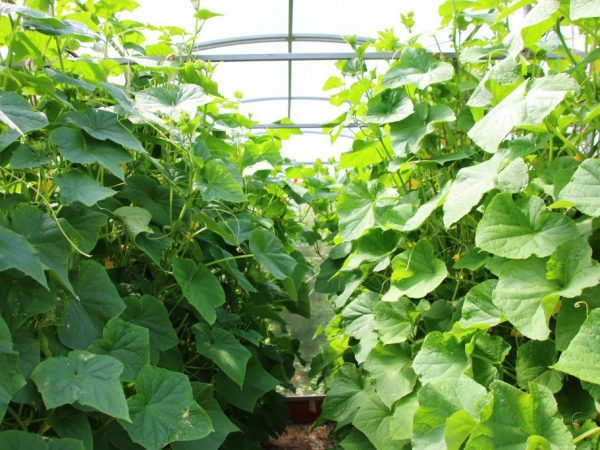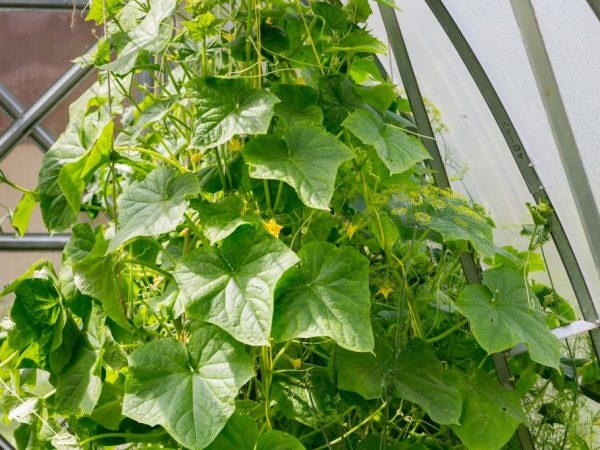How to form cucumbers in polycarbonate greenhouses
To achieve a good harvest, it is important to pay attention to each plant you grow. That is why, before carrying out the formation of cucumbers in a polycarbonate greenhouse, it is necessary not only to carefully select a variety, but also to read the instructions for caring for it.

Forming cucumbers in a polycarbonate greenhouse
Reasons for shaping
All varieties of cucumbers are divided into 2 groups:
- standard;
- hybrid (f1 is added to their names).
Non-traditional, non-new hybrid varieties should not grow without proper care, since each of them has its own characteristics of forming a bush in a greenhouse. There are a number of reasons for this:
- Strongly overgrown bushes are an excellent environment for the development of disease and the appearance of pests.
- If the territory and plants are not well-groomed, it is difficult for pollinating bees to get there. As a consequence, there are few ovaries on cucumbers.
- Correct plant growth allows rational use of the inner space of the greenhouse.
- Overgrown bushes in a polycarbonate greenhouse block other plants from the sun's rays. This affects their development and yield indicators.
- All the plant's strength goes into the growth of shoots, therefore, if the length of the lash is large, the quality and quantity of fruits leaves much to be desired.
- Correctly formed cucumber lashes make care and harvest much easier.
- Timely pinching prolongs the period of fruiting.
General rules of formation
More than 50 types of cucumbers are cultivated on the territory of the Russian Federation, which are intended for growing in open and greenhouse conditions. It is not difficult to form cucumbers correctly in a polycarbonate greenhouse: starting from 2 weeks after planting, the plant should be tied to a trellis.
The twine must be of high quality and non-slip. The lower end is passed under the first sheet. They make a free loop: the stem becomes denser as it grows. Do not over-pull the bandage: in strong winds, the bush will be torn out of the soil.
Plants form scourges in the first 2-3 months after planting. When the fruiting period begins, the grower should not allow the plantings to grow tightly next to each other.
If the greenhouse is heated, at the seedlings planted in January, no more than 12-15 fruits are left on the central stem. There should be no more than 3 fruits ripening at the same time. As the sunny day increases, an increase in the number of fruits is allowed.
If large leaves have formed in the upper part of the cucumber vine, thinning is carried out so that the lower tier is better illuminated.
Stepping

Grasshopping will provide light access to the plant
Grasshopping is one of the formation methods, involving the removal of excess leaves and ovaries from the main stem. This generates the nutritional energy of the shrub and directs it to the desired area. If there are many branches on a cucumber, they overshadow each other, as a result, the bush grows faster in order to receive more sunlight. To prevent this from happening, pinching is done.In greenhouse conditions, it happens like this:
- In the lower part of the bush, remove all flower rudiments and lateral shoots up to 4-5 leaves. This is done so that the lower part has full ventilation of the stem. This is the only way to avoid the development of diseases and decay. This stage is called the prevention of root rot.
- When the plant grows to 0.8-1.0 m, 2-3 shoots no more than 20 cm long and 1-2 leaves are left on the bush.
- As soon as the cucumber grows to the 1.3 m mark, the lateral processes should be about 35-40 cm, 2-3 ovaries and the same number of leaves are left on each of them.
- At a height of 1.5 m, 4 leaves and 3-4 ovaries should remain on each side shoot.
- If the lashes have grown to the maximum possible height, they are immediately tied up. There is a small exception, which is possible with a low greenhouse ceiling. In such a case, the whip is thrown down for further growth. When less than 20 cm remains to the ground, pinch it to stop development.
Particular attention is paid to the thinning of the leaves on the upper part. This is done as carefully as possible so as not to harm the shrub.
Pinching and trimming
Such actions are best done in the morning. Then, during the day, the process of plant recovery takes place. Cucumbers are fast growing, so flower ovaries develop in the lower part of the stem as the lash grows. They take a lot of energy from the main shoot, but do not bear fruit. For the normal formation of the root system, these sinuses are immediately removed.
When collecting fruits, it is important not to change the direction of growth of the lashes. This leads to yellowing of the leaves, which are immediately removed.
Pinching rules
- The procedure is carried out for young shoots to prevent their growth. If lashes longer than 20 cm are pinched, the plant is severely injured.
- For quick recovery, the leaves and shoots are cut with special scissors or a sharp knife.
- The leaves are cut as close to the stem as possible. It is impossible for hemp to remain: they are capable of causing powdery mildew.
- If there are many empty ovaries on the bush, they do not need to be removed. At the same time, the earth is dried, then from these barren flowers all useful substances will pass into fruits.
- The stem is wrapped around the cord clockwise 1-2 p. in Week. This is done carefully: it is fragile and breaks easily.
- Pinch antennae, damaged inflorescences and cucumbers. The tendrils take up most of the energy and nutrients, thereby interfering with the development of plants.
When pinching and tying whips, it is important to follow all the rules. Seedling is a young, unrooted plant, any manipulation or improper care done with it disrupts the root system.
Watering
In order to form a quality plant, it must develop normally. This requires watering and fertilization. The first watering is carried out in the soil of the greenhouse before planting seedlings. The earth is thoroughly moistened with water with the addition of specialized nutritional supplements.
During the growth of seedlings, watering is carried out as the soil dries. At the same time, it is important not to flood the plants, especially during the period of fruit ripening: due to excess water, they lose their natural taste, become watery.
An ideal option for greenhouse conditions is drip irrigation. With its help, plants receive the required amount of moisture. Having arranged such a system, the vegetable grower does not worry about the drying out of the bushes.
Conclusion
The cucumbers in the greenhouse need shaping. This allows you to get a richer harvest and monitor the health of the bushes.


